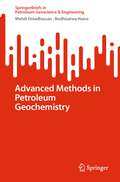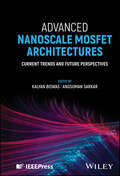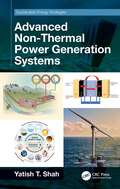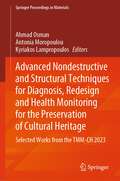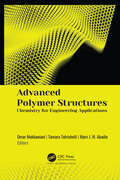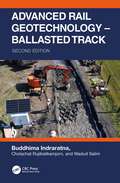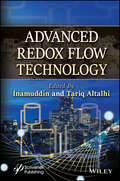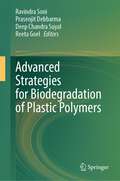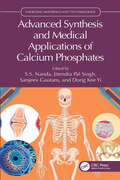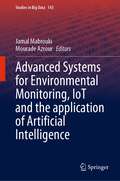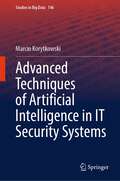- Table View
- List View
Advanced Mathematical Techniques in Computational and Intelligent Systems (Computational and Intelligent Systems)
by Sandeep Singh Aliakbar Montazer Haghighi Sandeep DalalThis book comprehensively discusses the modeling of real-world industrial problems and innovative optimization techniques such as heuristics, finite methods, operation research techniques, intelligent algorithms, and agent- based methods. Discusses advanced techniques such as key cell, Mobius inversion, and zero suffix techniques to find initial feasible solutions to optimization problems. Provides a useful guide toward the development of a sustainable model for disaster management. Presents optimized hybrid block method techniques to solve mathematical problems existing in the industries. Covers mathematical techniques such as Laplace transformation, stochastic process, and differential techniques related to reliability theory. Highlights application on smart agriculture, smart healthcare, techniques for disaster management, and smart manufacturing. Advanced Mathematical Techniques in Computational and Intelligent Systems is primarily written for graduate and senior undergraduate students, as well as academic researchers in electrical engineering, electronics and communications engineering, computer engineering, and mathematics.
Advanced Metal Ion Storage Technologies: Beyond Lithium-Ion Batteries
This book focusses on the current research on materials for advanced battery technologies and proposes future directions for different types of batteries to meet the current challenges associated with the fuel cell. Furthermore, it provides insights into scientific and practical issues in the development of various batteries like sodium, potassium, zinc, magnesium, aluminum, calcium, and dual metal ion, to bring a new perspective to storage technologies beyond lithium-ion batteries. It introduces different themes of batteries to evaluate the opportunities and challenges of these battery systems from a commercial aspect. Key features: Deals with different potential rechargeable battery systems as suitable substitutes for LIBs Discusses different investigated materials as anode, cathode, and electrolytes for different energy storage systems Provides a complete and comprehensive review of all the existing metal-ion batteries Includes practical challenges and future opportunities of each battery category Reviews commercial aspects of different battery systems This book is aimed at researchers, graduate students, and professionals in industrial and applied chemistry, renewable energy, clean and sustainable processes, chemical engineering, materials science, nanotechnology, and battery chemistry.
Advanced Metal Ion Storage Technologies: Beyond Lithium-Ion Batteries
by Ranjusha Rajagopalan Haiyan Wang Yougen TangThis book focusses on the current research on materials for advanced battery technologies and proposes future directions for different types of batteries to meet the current challenges associated with the fuel cell. Furthermore, it provides insights into scientific and practical issues in the development of various batteries like sodium, potassium, zinc, magnesium, aluminum, calcium, and dual metal ion, to bring a new perspective to storage technologies beyond lithium-ion batteries. It introduces different themes of batteries to evaluate the opportunities and challenges of these battery systems from a commercial aspect. Key features: Deals with different potential rechargeable battery systems as suitable substitutes for LIBs Discusses different investigated materials as anode, cathode, and electrolytes for different energy storage systems Provides a complete and comprehensive review of all the existing metal-ion batteries Includes practical challenges and future opportunities of each battery category Reviews commercial aspects of different battery systems This book is aimed at researchers, graduate students, and professionals in industrial and applied chemistry, renewable energy, clean and sustainable processes, chemical engineering, materials science, nanotechnology, and battery chemistry.
Advanced Methods in Petroleum Geochemistry (SpringerBriefs in Petroleum Geoscience & Engineering)
by Mehdi Ostadhassan Bodhisatwa HazraThis brief presents recent developments and new methodologies in the area of petroleum geochemistry, including innovative unconventional analytical methods such as Raman, NMR and XPS spectroscopy that are based on advanced analytical chemistry and recently developed instrumentation. It discusses delineating mechanisms for petroleum generation, expulsion, migration and accumulation in reservoirs from the source rock. This brief provides data, illustrations and detailed explanation of each method discussed, as well as data collection, interpretation of the results and intercorrelated characteristics of different case studies from a variety of samples. Geologists, engineers, and graduate students interested in the petroleum industry will all find the book valuable.
Advanced MOS Devices and their Circuit Applications
by Ankur Beohar Ribu Mathew Abhishek Kumar Upadhyay Santosh Kumar VishvakarmaThis text comprehensively discusses the advanced MOS devices and their circuit applications with reliability concerns. Further, an energy-efficient Tunnel FET-based circuit application will be investigated in terms of the output voltage, power efficiency, energy consumption, and performances using the device circuit co-design approach. The book: • Discusses advanced MOS devices and their circuit design for energy- efficient systems on chips (SoCs).• Covers MOS devices, materials, and related semiconductor transistor technologies for the next-generation ultra-low-power applications.• Examines the use of field-effect transistors for biosensing circuit applications and covers reliability design considerations and compact modeling of advanced low-power MOS transistors.• Includes research problem statements with specifications and commercially available industry data in the appendix.• Presents Verilog-A model-based simulations for circuit analysis. The volume provides detailed discussions of DC and analog/RF characteristics, effects of trap-assisted tunneling (TAT) for reliability analysis, spacer-underlap engineering methodology, doping profile analysis, and work-function techniques. It further covers novel MOS devices including FinFET, Graphene field-effect transistor, Tunnel FETS, and Flash memory devices. It will serve as an ideal design book for senior undergraduate students, graduate students, and academic researchers in the fields including electrical engineering, electronics and communication engineering, computer engineering, materials science, nanoscience, and nanotechnology.
Advanced MOS Devices and their Circuit Applications
by Ankur Beohar Ribu Mathew Abhishek Kumar Upadhyay Santosh Kumar VishvakarmaThis text comprehensively discusses the advanced MOS devices and their circuit applications with reliability concerns. Further, an energy-efficient Tunnel FET-based circuit application will be investigated in terms of the output voltage, power efficiency, energy consumption, and performances using the device circuit co-design approach. The book: • Discusses advanced MOS devices and their circuit design for energy- efficient systems on chips (SoCs).• Covers MOS devices, materials, and related semiconductor transistor technologies for the next-generation ultra-low-power applications.• Examines the use of field-effect transistors for biosensing circuit applications and covers reliability design considerations and compact modeling of advanced low-power MOS transistors.• Includes research problem statements with specifications and commercially available industry data in the appendix.• Presents Verilog-A model-based simulations for circuit analysis. The volume provides detailed discussions of DC and analog/RF characteristics, effects of trap-assisted tunneling (TAT) for reliability analysis, spacer-underlap engineering methodology, doping profile analysis, and work-function techniques. It further covers novel MOS devices including FinFET, Graphene field-effect transistor, Tunnel FETS, and Flash memory devices. It will serve as an ideal design book for senior undergraduate students, graduate students, and academic researchers in the fields including electrical engineering, electronics and communication engineering, computer engineering, materials science, nanoscience, and nanotechnology.
Advanced Nanomaterials and Their Applications
by Bikash Sharma Chandan Kumar SarkarThis book covers various facets of nanomaterials and their applications including low-dimensional materials along with discussions on in vitro cell imaging, bioanalyses, UV laser applications of scheelite-type nanomaterials, and nanosized cyanobridged metal-organic frameworks, including high spin transition metal ions. It explains transition metal dichalcogenides and magnetic tunnel junction devices as an alternative to complementary metal-oxide semiconductors. One of the main aims of this book is to grow interest in the atomistic simulation process and characterization of these nanoscale devices. Details the recent advances in the application of nanomaterials for nanoelectronics devices, sensors, and memories Describes the first-principles approach to ultrasensitive electrically doped biosensors Discusses the application of nanomaterials in spintronic devices, specifically magnetic tunnel junction devices with new architectures Covers nanomaterials in water purification and conducting polymer nanocomposites in electrochemical supercapacitors Presents the theoretical background of next-generation MRI contrast agents with nanosized cyanobridged metal-organic frameworks including high spin transition metal ions This book is aimed at researchers and graduate students of materials engineering and nanoelectronics.
Advanced Nanomaterials and Their Applications
This book covers various facets of nanomaterials and their applications including low-dimensional materials along with discussions on in vitro cell imaging, bioanalyses, UV laser applications of scheelite-type nanomaterials, and nanosized cyanobridged metal-organic frameworks, including high spin transition metal ions. It explains transition metal dichalcogenides and magnetic tunnel junction devices as an alternative to complementary metal-oxide semiconductors. One of the main aims of this book is to grow interest in the atomistic simulation process and characterization of these nanoscale devices. Details the recent advances in the application of nanomaterials for nanoelectronics devices, sensors, and memories Describes the first-principles approach to ultrasensitive electrically doped biosensors Discusses the application of nanomaterials in spintronic devices, specifically magnetic tunnel junction devices with new architectures Covers nanomaterials in water purification and conducting polymer nanocomposites in electrochemical supercapacitors Presents the theoretical background of next-generation MRI contrast agents with nanosized cyanobridged metal-organic frameworks including high spin transition metal ions This book is aimed at researchers and graduate students of materials engineering and nanoelectronics.
Advanced Nanoscale MOSFET Architectures: Current Trends and Future Perspectives
by Angsuman Sarkar Kalyan BiswasComprehensive reference on the fundamental principles and basic physics dictating metal–oxide–semiconductor field-effect transistor (MOSFET) operation Advanced Nanoscale MOSFET Architectures provides an in-depth review of modern metal–oxide–semiconductor field-effect transistor (MOSFET) device technologies and advancements, with information on their operation, various architectures, fabrication, materials, modeling and simulation methods, circuit applications, and other aspects related to nanoscale MOSFET technology. The text begins with an introduction to the foundational technology before moving on to describe challenges associated with the scaling of nanoscale devices. Other topics covered include device physics and operation, strain engineering for highly scaled MOSFETs, tunnel FET, graphene based field effect transistors, and more. The text also compares silicon bulk and devices, nanosheet transistors and introduces low-power circuit design using advanced MOSFETs. Additional topics covered include: High-k gate dielectrics and metal gate electrodes for multi-gate MOSFETs, covering gate stack processing and metal gate modification Strain engineering in 3D complementary metal-oxide semiconductors (CMOS) and its scaling impact, and strain engineering in silicon–germanium (SiGe) FinFET and its challenges and future perspectives TCAD simulation of multi-gate MOSFET, covering model calibration and device performance for analog and RF applications Description of the design of an analog amplifier circuit using digital CMOS technology of SCL for ultra-low power VLSI applications Advanced Nanoscale MOSFET Architectures helps readers understand device physics and design of new structures and material compositions, making it an important resource for the researchers and professionals who are carrying out research in the field, along with students in related programs of study.
Advanced Nanoscale MOSFET Architectures: Current Trends and Future Perspectives
by Angsuman Sarkar Kalyan BiswasComprehensive reference on the fundamental principles and basic physics dictating metal–oxide–semiconductor field-effect transistor (MOSFET) operation Advanced Nanoscale MOSFET Architectures provides an in-depth review of modern metal–oxide–semiconductor field-effect transistor (MOSFET) device technologies and advancements, with information on their operation, various architectures, fabrication, materials, modeling and simulation methods, circuit applications, and other aspects related to nanoscale MOSFET technology. The text begins with an introduction to the foundational technology before moving on to describe challenges associated with the scaling of nanoscale devices. Other topics covered include device physics and operation, strain engineering for highly scaled MOSFETs, tunnel FET, graphene based field effect transistors, and more. The text also compares silicon bulk and devices, nanosheet transistors and introduces low-power circuit design using advanced MOSFETs. Additional topics covered include: High-k gate dielectrics and metal gate electrodes for multi-gate MOSFETs, covering gate stack processing and metal gate modification Strain engineering in 3D complementary metal-oxide semiconductors (CMOS) and its scaling impact, and strain engineering in silicon–germanium (SiGe) FinFET and its challenges and future perspectives TCAD simulation of multi-gate MOSFET, covering model calibration and device performance for analog and RF applications Description of the design of an analog amplifier circuit using digital CMOS technology of SCL for ultra-low power VLSI applications Advanced Nanoscale MOSFET Architectures helps readers understand device physics and design of new structures and material compositions, making it an important resource for the researchers and professionals who are carrying out research in the field, along with students in related programs of study.
Advanced Non-Thermal Power Generation Systems (Sustainable Energy Strategies)
by Yatish T. ShahGenerally, sources for power generation are broken down into two categories: thermal and non-thermal. Thermal sources for power generation include combustion, geothermal, solar, nuclear, and waste heat, which essentially provide heat as a means for power generation. This book examines non-thermal (mechanical, electrochemical, nanoscale self-powered, and hybrid) sources of power generation and emphasizes recent advances in distributed power generation systems. Key Features Details recent advances made in wind power, including onshore, offshore, fixed and floating platform, and air wind energy systems, and offers detailed assessments of progress Covers advances in generation of hydropower, exploring dam hydropower, novel wave energy converters, and novel systems and turbines for hydrokinetic energy conversion to power Examines all types of fuel cells and their multi-functional roles, along with hybrid fuel cell systems in complete detail Explores advances in the development of self-powered nanogenerators for use in portable, wearable, and implantable power electronics Focuses on technologies with the best commercial possibilities and provides perspectives on future challenges that need to be solved This book will be of value to all researchers in academia, industry, and government interested in pursuing power generation technologies and seeking a comprehensive understanding of available and emerging non-thermal power generation sources. Readers who are interested in learning about thermal power generation sources can find it in the author’s companion text Advanced Power Generation Systems: Thermal Sources (2023).
Advanced Non-Thermal Power Generation Systems (Sustainable Energy Strategies)
by Yatish T. ShahGenerally, sources for power generation are broken down into two categories: thermal and non-thermal. Thermal sources for power generation include combustion, geothermal, solar, nuclear, and waste heat, which essentially provide heat as a means for power generation. This book examines non-thermal (mechanical, electrochemical, nanoscale self-powered, and hybrid) sources of power generation and emphasizes recent advances in distributed power generation systems. Key Features Details recent advances made in wind power, including onshore, offshore, fixed and floating platform, and air wind energy systems, and offers detailed assessments of progress Covers advances in generation of hydropower, exploring dam hydropower, novel wave energy converters, and novel systems and turbines for hydrokinetic energy conversion to power Examines all types of fuel cells and their multi-functional roles, along with hybrid fuel cell systems in complete detail Explores advances in the development of self-powered nanogenerators for use in portable, wearable, and implantable power electronics Focuses on technologies with the best commercial possibilities and provides perspectives on future challenges that need to be solved This book will be of value to all researchers in academia, industry, and government interested in pursuing power generation technologies and seeking a comprehensive understanding of available and emerging non-thermal power generation sources. Readers who are interested in learning about thermal power generation sources can find it in the author’s companion text Advanced Power Generation Systems: Thermal Sources (2023).
Advanced Nondestructive and Structural Techniques for Diagnosis, Redesign and Health Monitoring for the Preservation of Cultural Heritage: Selected Works from the TMM-CH 2023 (Springer Proceedings in Materials #33)
by Ahmad Osman Antonia Moropoulou Kyriakos LampropoulosThis book comprises the proceedings of the third TMM_CH International Conference on "Transdisciplinary Multispectral Modelling and Cooperation for the Preservation of Cultural Heritage." This book showcases the latest advancements in non-destructive testing and structural techniques across a wide range of applications within the realm of cultural heritage. The conference, held at the esteemed Eugenides Foundation in Athens, Greece, brought together scientists, engineers, architects, archeologists, conservators, geologists, art historians, and other stakeholders. Thirteen sessions and panel discussions featuring 142 esteemed panelists provided a platform for the exchange of ideas. With a significant online presence and approximately 50,000 online viewers, the conference had a profound impact on a global scale. This book serves as a valuable resource, presenting recent scientific breakthroughs, non-destructive techniques, and technologies that contribute to the holistic preservation of our world's cultural heritage.
Advanced Polymer Structures: Chemistry for Engineering Applications
Taking an interdisciplinary approach, this new book considers state-of-the-art developments and research in polymer science, such as advanced polymers, composites and nanocomposites, and the role of polymers in the progress of green chemistry and medicine. Polymers are studied in fields as diverse as polymer science (polymer chemistry and polymer physics), biophysics, biochemistry, and more generally in materials science and engineering. Polymer matrix composites (PMCs) and nanocomposites (PMNCs) are widely used in hightech material structures such as in the automotive, marine, and aerospace industries. Their impact on the physical and mechanical performance is mainly due to their reinforcing agents, fibers (glass, carbon, aramid) or nanofibers (MMT, CNTs, graphene, etc) but also due to a perfect mastery of the matrix/reinforcement interface.
Advanced Polymer Structures: Chemistry for Engineering Applications
by Omar Mukbaniani Tamara Tatrishvili Marc Jean M. AbadieTaking an interdisciplinary approach, this new book considers state-of-the-art developments and research in polymer science, such as advanced polymers, composites and nanocomposites, and the role of polymers in the progress of green chemistry and medicine. Polymers are studied in fields as diverse as polymer science (polymer chemistry and polymer physics), biophysics, biochemistry, and more generally in materials science and engineering. Polymer matrix composites (PMCs) and nanocomposites (PMNCs) are widely used in hightech material structures such as in the automotive, marine, and aerospace industries. Their impact on the physical and mechanical performance is mainly due to their reinforcing agents, fibers (glass, carbon, aramid) or nanofibers (MMT, CNTs, graphene, etc) but also due to a perfect mastery of the matrix/reinforcement interface.
Advanced Rail Geotechnology – Ballasted Track
by Buddhima Indraratna Cholachat Rujikiatkamjorn Wadud SalimBallast plays a vital role in transmitting and distributing the train wheel loads to the underlying track substructure. The load-bearing capacity, safe train speed, and the levels of noise and vibration, as well as passenger comfort depend on the behaviour of ballast through particle interlocking and the corresponding deformation of this granular assembly. Attrition and breakage of ballast occur progressively under heavy and continual cyclic loading, causing track deterioration and rail misalignment affecting safety, while exacerbating the intensity of track maintenance. In the absence of realistic computational models, the track substructure is traditionally designed using mostly empirical approaches. In this book, the authors present the detailed information on the strength, deformation, and degradation aspects of fresh and recycled ballast under monotonic, cyclic, and impact loading using innovative geotechnical testing devices. A constitutive model for ballast incorporating particle breakage is presented representing a more realistic stress–strain response. The mathematical formulations and numerical models are validated using controlled experimental simulations and fully instrumented field trials. Revised ballast gradation is described to provide greater track resiliency and extended longevity. The book also provides a detailed description of geosynthetics for substructure improvement considering track deterioration caused by particle degradation, fouling, and impeded drainage. New to this second edition are extensive discussions on subgrade soil stabilisation, causes and mechanisms of soil fluidisation (mud pumping) under cyclic loading, and preventive and remedial measures to alleviate undue instability of ballast tracks. This book should prove most beneficial for final-year civil engineering students and for postgraduate teaching and learning. It is an ideal supplement for practising railway engineers and researchers engaged in the challenging tasks of future track design for heavier and faster trains.
Advanced Rail Geotechnology – Ballasted Track
by Buddhima Indraratna Cholachat Rujikiatkamjorn Wadud SalimBallast plays a vital role in transmitting and distributing the train wheel loads to the underlying track substructure. The load-bearing capacity, safe train speed, and the levels of noise and vibration, as well as passenger comfort depend on the behaviour of ballast through particle interlocking and the corresponding deformation of this granular assembly. Attrition and breakage of ballast occur progressively under heavy and continual cyclic loading, causing track deterioration and rail misalignment affecting safety, while exacerbating the intensity of track maintenance. In the absence of realistic computational models, the track substructure is traditionally designed using mostly empirical approaches. In this book, the authors present the detailed information on the strength, deformation, and degradation aspects of fresh and recycled ballast under monotonic, cyclic, and impact loading using innovative geotechnical testing devices. A constitutive model for ballast incorporating particle breakage is presented representing a more realistic stress–strain response. The mathematical formulations and numerical models are validated using controlled experimental simulations and fully instrumented field trials. Revised ballast gradation is described to provide greater track resiliency and extended longevity. The book also provides a detailed description of geosynthetics for substructure improvement considering track deterioration caused by particle degradation, fouling, and impeded drainage. New to this second edition are extensive discussions on subgrade soil stabilisation, causes and mechanisms of soil fluidisation (mud pumping) under cyclic loading, and preventive and remedial measures to alleviate undue instability of ballast tracks. This book should prove most beneficial for final-year civil engineering students and for postgraduate teaching and learning. It is an ideal supplement for practising railway engineers and researchers engaged in the challenging tasks of future track design for heavier and faster trains.
Advanced Redox Flow Technology
by InamuddinADVANCED REDOX FLOW TECHNOLOGY This book serves as a comprehensive guide to redox flow technologies, from their basic principles to their applications. As a result, this book provides a thorough review of craftsmanship in the subject, as well as the potential for future advances. As energy becomes a greater global concern, redox flow technology must be considered as a possibility. There is concern over energy shortages and rising air pollution, paving the way for renewable energies like solar and wind energy which have been extensively analyzed and evaluated in recent years. These renewable sources, on the other hand, are intermittent and frequently unpredictably available, resulting in low-quality output energy and a negative influence on grid stability. To date, diverse types of energy storage systems have been designed for various purposes, each with its own set of benefits and drawbacks. In recent years, redox flow technology, particularly vanadium redox flow, has progressed substantially. Experiments at various scales have been successfully carried out, proving the viability of redox flow technology in bulk energy storage applications. In addition, innovative redox flow technologies that offer more energy storage per unit mass or a more cost-effective volume of the storage device have attracted a lot of interest. This book is intended to serve as a comprehensive guide to redox flow technologies, from their basic principles to their applications. As a result, this book provides a thorough review of the craftsmanship in the subject, as well as the potential for future advances. Advanced redox flow technology has sparked interest in bulk energy storage due to its flexibility in design, safety in operation, efficient energy storage, and near-zero environmental impact. The technology has been extensively developed and tested at a range of levels in recent years, demonstrating its applicability and usage.
Advanced Redox Flow Technology
by Inamuddin Tariq AltalhiADVANCED REDOX FLOW TECHNOLOGY This book serves as a comprehensive guide to redox flow technologies, from their basic principles to their applications. As a result, this book provides a thorough review of craftsmanship in the subject, as well as the potential for future advances. As energy becomes a greater global concern, redox flow technology must be considered as a possibility. There is concern over energy shortages and rising air pollution, paving the way for renewable energies like solar and wind energy which have been extensively analyzed and evaluated in recent years. These renewable sources, on the other hand, are intermittent and frequently unpredictably available, resulting in low-quality output energy and a negative influence on grid stability. To date, diverse types of energy storage systems have been designed for various purposes, each with its own set of benefits and drawbacks. In recent years, redox flow technology, particularly vanadium redox flow, has progressed substantially. Experiments at various scales have been successfully carried out, proving the viability of redox flow technology in bulk energy storage applications. In addition, innovative redox flow technologies that offer more energy storage per unit mass or a more cost-effective volume of the storage device have attracted a lot of interest. This book is intended to serve as a comprehensive guide to redox flow technologies, from their basic principles to their applications. As a result, this book provides a thorough review of the craftsmanship in the subject, as well as the potential for future advances. Advanced redox flow technology has sparked interest in bulk energy storage due to its flexibility in design, safety in operation, efficient energy storage, and near-zero environmental impact. The technology has been extensively developed and tested at a range of levels in recent years, demonstrating its applicability and usage.
Advanced Strategies for Biodegradation of Plastic Polymers
by Ravindra Soni Prasenjit Debbarma Deep Chandra Suyal Reeta GoelSynthetic plastic offers a wide range of utilities because of its physico-chemical properties, thus the demand for its commercial availability and generation of waste is inevitable. Although the scientists have proved over the years that plastics can be efficiently biodegraded by different potential microorganisms, this sustainable green technology is still in the cocoon phase and overlooked by the industry and government as well. Therefore, this book will showcase the cutting-edge microbial tools to mitigate the plastic waste sustainably in consideration of latest technologies and recent strategic advancements besides discussing the global plastic production and their impacts on environment. It will also provide the present status and future perspectives of the environmental clean-up technologies. Moreover, it is an effort to ascertain the potential areas for large-scale biodegradation or pilot scale or start-up ventures in the field of plastic remediation strategy.
Advanced Synthesis and Medical Applications of Calcium Phosphates (Emerging Materials and Technologies)
Calcium phosphate materials are used in many medical and dental applications. Advanced Synthesis and Medical Applications of Calcium Phosphates covers the structure, chemistry, synthesis, and properties of both natural and synthetic calcium-based biomaterials and details a variety of medical applications. Depicts the latest advances in using calcium phosphates in bone regeneration and tissue engineering Includes the latest generation of regenerative biomaterials with an integrated perspective combining both research and clinical issues Provides an understanding of the clinical targets and requirements for regenerative medicine Detailing fundamentals through applications, this book helps biomaterials researchers to better understand the clinical targets and requirements for use of these materials for optimal synthesis and development.
Advanced Synthesis and Medical Applications of Calcium Phosphates (Emerging Materials and Technologies)
by S. S. Nanda Jitendra Pal Singh Sanjeev Gautam Dong Kee YiCalcium phosphate materials are used in many medical and dental applications. Advanced Synthesis and Medical Applications of Calcium Phosphates covers the structure, chemistry, synthesis, and properties of both natural and synthetic calcium-based biomaterials and details a variety of medical applications. Depicts the latest advances in using calcium phosphates in bone regeneration and tissue engineering Includes the latest generation of regenerative biomaterials with an integrated perspective combining both research and clinical issues Provides an understanding of the clinical targets and requirements for regenerative medicine Detailing fundamentals through applications, this book helps biomaterials researchers to better understand the clinical targets and requirements for use of these materials for optimal synthesis and development.
Advanced System Development Technologies I (Studies in Systems, Decision and Control #511)
by Mykhailo Bezuglyi Nadiia Bouraou Volodymyr Mykytenko Grygoriy Tymchyk Artur ZaporozhetsThis book covers vibroacoustic monitoring, inertial attitude systems, and control system for device processing in complex objects. Modern approaches to the synthesis of algorithmic support for a strapdown inertial attitude system are considered. The general characteristics of navigation systems and the composition of their inertial measurement unit are given. The methods of initial alignment of the system on a stationary base are described. Particular attention is paid to the attitude kinematic parameters of the body frame and methods of their numerical integration. Picard's methods for integrating the Bortz and Poisson kinematic equations are shown. An algorithm for a strapdown inertial attitude system based on using real signals of high-precision laser gyroscopes is proposed. System simulation was carried out using the proposed algorithmic methods. The relevance of the control system created for the processing device parts in the conditions of automated manufacturing is substantiated. Theoretical studies are presented, and the relation between electrical signals, the level of tool wear, and the main reasons for generating electrical signals are identified. A mathematical model of cutting tool wear control was developed based on measuring the variable component of cutting electromotive force. A control system for processing device parts on computer numerical control machines in automated production conditions has been developed. It allows for recording critical wear and breakage of the cutting tool, performing its dimensional adjustment directly on the device, and carrying out its industrial approval in flexible production systems.
Advanced Systems for Environmental Monitoring, IoT and the application of Artificial Intelligence (Studies in Big Data #143)
by Jamal Mabrouki Mourade AzrourEnvironmental risks put one in six people at risk, as well as our complex ecosystems. Today, IoT sites can monitor the environment and assess risks. Clean technologies can help detect toxic substances, chemical spills, hazardous pollutants, and other issues, enabling both governments and industries to clean or protect the air, land, water, and other environments, and how IoT can support these processes. IoT-enabled environmental intelligence is the constant measurement and collection of our physical environment, through sensors and smart devices. Integrated sensors in irrigation facilities, water supply systems, pipelines, cisterns, weather stations, ocean, and industrial facilities—anywhere on the globe—can record temperature, relative humidity, water content, leaks, and any other physical parameters.
Advanced Techniques of Artificial Intelligence in IT Security Systems (Studies in Big Data #146)
by Marcin KorytkowskiThe book explores how modern technologies, including artificial intelligence and neural networks, are being used to enhance cybersecurity. In today's world, the development of the Internet is nothing short of transformative, affecting every aspect of our lives. Ensuring the safety of its users is a paramount concern, and it requires a diverse set of disciplines to address. Researchers from various fields, including IT, mathematics, psychology, and medicine, are collectively working to tackle this interdisciplinary challenge. The significance of this issue has been magnified by the COVID-19 pandemic, which forced many aspects of our lives into the digital realm, from online payments to remote work and education. This shift brought new security challenges, with data privacy and system integrity taking center stage. It delves into the intricacies of Big Data by having to analyze an immense volume of network traffic data that can only be effectively analyzed with specialized tools. Real-time threat detection is critical, and the book sheds light on cutting-edge approaches to achieving this goal. The content of the book covers a broad spectrum of topics related to IT system security, from user and system profiling to preventing data leaks and defending against phishing attacks. Additionally, innovative concepts such as “glial networks” are introduced, offering new ways to interpret knowledge stored in convolutional networks. These solutions are not limited to security alone; they have applications across various domains. The book highlights the advantages of these cutting-edge approaches over existing methods, demonstrating their relevance to large corporations, public institutions, schools, small businesses, and households. In a world where security threats are constantly evolving, this book is a valuable resource for understanding the dynamic landscape of network security and the role of artificial intelligence in safeguarding our digital ecosystems.


